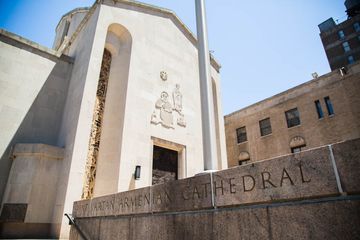With construction starting in 1958 and finishing ten years later, Saint Vartan Cathedral represents the first Armenian Apostolic cathedral built in North America. Named after a saint who was martyred a millennium and a half ago defending Armenian Christianity, Saint Vartan Cathedral had a memorable beginning. During its construction and immediately following its completion, the building was visited by the highest authority within the Church, His Holiness Vasken I, marking the first such visit by a Supreme Patriarch and Catholicos of All Armenians in the United States. For a people so persecuted throughout history, and especially by the recent Armenian genocide, the building and consecration of this holy house was a monumental event in the community. His Holiness Vasken I, looking out at an assembled audience soon after Saint Vartan's completion, spoke of "an admirable picture of spiritual grace - a rare moment of spiritual bliss - to which we are all witnesses. " But far from being a relic, the church continues to thrive with the energy of the community it houses. I encourage any visitors to the church to walk through the intricately decorated doors and take some time to absorb the sheer size and depth of the church. Narrow strips of stained glass depicting biblical scenes and significant events in the history of the Armenian Church rise up to the impressive dome, which depicts Christian symbols in paint and stained glass, such as a human eye within a triangle (representing the omniscient Triune God), the wooden ship (representing the Church), and the white dove (representing the Holy Spirit). Closer to the altar, the “Head of Christ” is chiseled on a slate of stone in high relief. Silver and gold crosses decorate the distinctly Armenian altar. On the sides of the altar are paintings of St. Sahag and St. Mesrob, the two men credited with inventing the Armenian Alphabet, and a painting that seeks to honor the victims of the dreadful Armenian genocide.

